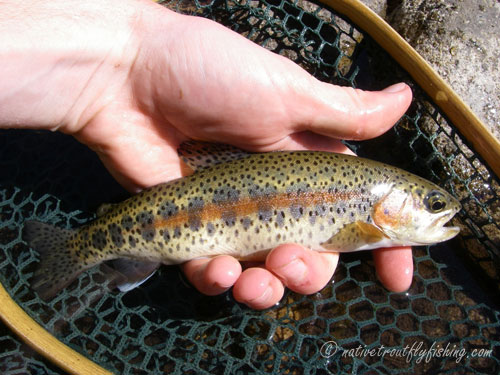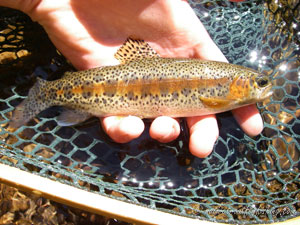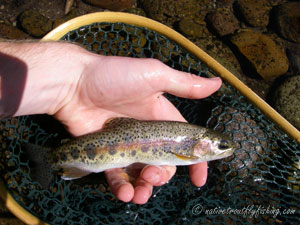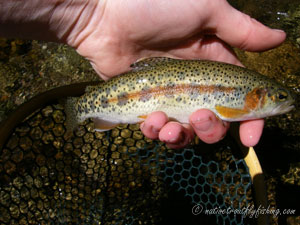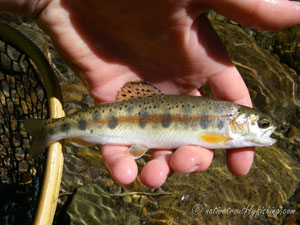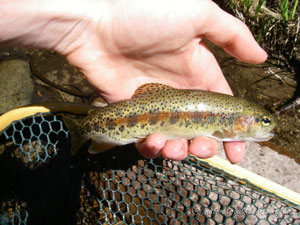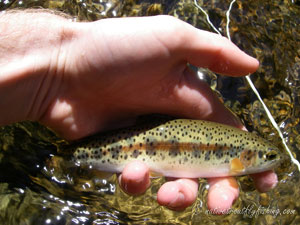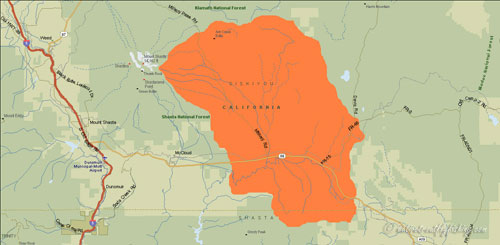McCloud River Redband
Oncorhynchus mykiss calisulat
A McCloud River Redband from a small spring fed stream in northern California
Introduction
The McCloud River Redband Trout is native to the McCloud River in Northern California, above McCloud Falls, as well as in several isolated headwater streams. These trout represent a primitive form of Rainbow Trout that are thought to have colonized the Sacramento River basin prior to Coastal Rainbow Trout (Nieslen et al. 1999). The McCloud River Redband Trout were originally lumped with the with Sacramento Redband Trout, described as a distinct species: Salmo stonei from specimens caught in the lower McCloud in 1894 in honor of Livingston Stone who operated the nation's first fish hatchery, which was located on the McCloud River. The Redband Trout from Sheephaven Creek in the upper McCloud basin were proposed to represent a distinct subspecies but were never formally described (Behnke 2002). However, recent evidence has shown that the Redband Trout upstream of the waterfalls on the McCloud River, included fish found in Sheephaven Creek and other nearby tributaries are morphologically, genetically distinct from the Redbands downstream and in the nearby Pit River (Campbell et al. 2023). These McCloud River Redband Trout were formally described as a new subspecies Oncorhynchus mykiss calisulat in 2023, from the Winnemem Wintu words cali sulat for beautiful trout.
Life History Information
The McCloud River Redband Trout exist as stream resident and fluvial populations in the McCloud River and its tributaries above the Middle Falls of the McCloud River. Many of the streams in their native range originate on the slopes of Mount Shasta, where soil is composed of porous volcanic ash. Due to this most of the tributaries to the upper McCloud River are isolated from each other and begin as springs before sinking back into the ground a short distance downstream. The little life history information available for McCloud River Redband Trout suggest patterns similar to other small stream Rainbow Trout populations. Trout in these small stream populations reach a maximum size of around 12” (30 cm) with a lifespan of three to seven years. The Redbands found the McCloud River are known to reach sizes of up to 20” (50.8 cm) and weights up to 3 lbs. (1.4 kg). McCloud River Redbands are opportunistic feeders and have a diet primary composed of aquatic insects and supplemented with terrestrial insects in the summer, which may make up as much as fifty percent of their diet (Behnke 2002). These trout typically reach sexual maturity at around two years of age and spawn primarily in June (USFS 1998).
Status
Redband Trout in the McCloud basin were proposed as a candidate species for federal endangered status (USFWS 1994) and designated by the California Department of Fish and Game (CDFG) as a state species of special concern (Moyle et al. 2008). The Redband Trout of the McCloud River drainage are highly susceptible to hybridization with hatchery Rainbow Trout and due to this, CDFW discontinued all Rainbow Trout stocking in the basin in 1994. In the McCloud River above the falls, there appears to be a 25%-to 50% influence of hatchery Rainbow Trout and only four streams in the basin are deemed to not be significantly introgressed with Rainbow Trout (Simmons et al. 2009). Predation on juvenile Redbands by Brown Trout and the spread of diseases from introduced fish are also thought to be a major factor in the declines of some McCloud River Redband populations (Moyle et al. 2008). Beyond the introduction of non-native fish, logging and grazing have degraded the quality of the stream habitat available to the McCloud Redbands threatening the viability of these populations. Grazing activity has occurred since the mid 1800's when homesteaders began settling in the McCloud River basin. At that point in time there was little impact on the basin's native trout, but by the 1940's there were over 35,000 animals: primarily sheep grazing in the basin (USFS 1998). Shortly after the end of World War II grazing in the basin dropped off considerably and the habitat improved, but some grazing allotments remain today and continue to cause habitat degradation. Together logging and grazing have led to loss of riparian habitat, trampling of stream banks, reduced stream flow, sedimentation, and increased stream temperatures. Climate change is another factor that threatens McCloud River Redbands and recent droughts have led to high stream temperatures and streams drying up. As such CDFW has had to recently use hatchery intervention to prevent populations from disappearing. Due to the small, isolated nature of the remaining McCloud River Redband populations habitat protection and the removal of non-native species will be crucial to ensuring that subspecies survives into the future.
Description
McCloud River Redband Trout have an olive or bronze coloration on their backs. Their sides are a yellowish to golden color that may be quite intense and fades toward the ventral region, with an orange coloration found on the bellies of some sexually mature individuals. Like other Redband Trout, McCloud River Redband may exhibit cutthroat marks under their jaws. These fish get their name Redband from a pink to brick red stripe along their lateral line. Their gill plates are a rosy or brick red color which is rather intense on some individuals. McCloud River Redbands are heavily spotted above the lateral line and have a few spots below. Purplish colored elliptical shaped parr marks are often retained into maturity on stream resident fish but fade on migratory fish. The dorsal fin may be tipped with either orange or white and the lower fins are tipped with white.
Stream Resident Form
Click on images to view a larger picture
Native Range
A map of the native range of the McCloud River redband trout. Data Sources: Behnke (2002) and Nielsen et al. (1999).
References
Campbell, M.A., E. Habibi, G. Aubringer, M. Stephens, J. Rodzen, K.W. Conway, A.J. Finger. 2023. Molecular systematics of redband trout from genome-wide DNA sequencing substantiates the description of a new taxon (Salmonidae: Oncorhynchus mykiss calisulat) from the McCloud River. Zootaxa 5254 (1): 000-029. https://doi.org/10.11646/zootaxa.5254.1.1
Behnke, R. 2002. Trout and Salmon of North America. Chanticleer Press, New York.
Moyle, P.B., J.A. Israel and S.E. Purdy. 2008. SOS: California's native fish crisis: Status of and solutions for restoring our vital salmon, steelhead and trout populations. California Trout, San Francisco, CA.
Nielsen, J.L., K.D. Crow and M.C. Fountain. 1999. Microsatellite diversity and conservation of a relic trout population: McCloud River redband trout. Molecular Ecology 8: S129-S142.
Simmons, R.E., P. Lavretsky and B. May. 2009. Introgressive hybridization of redband trout in the Upper McCloud River watershed. Transactions of the American Fisheries Society 139: 201–213.
USFS (United States Forest Service). 1998. Redband trout conservation agreement. United States Forest Service, Redding, CA.
USFWS (United States Fish and Wildlife Service). 1994. Endangered and threatened wildlife and plants; animal candidate review for listing as endangered or threatened species. Federal Register 59(219):58982-59028.
Contact
Feel free to contact me if you have any questions or comments
McCloud River Redband Trout Links
My McCloud River Redband Trips
California Department of Fish and Wildlife - McCloud River Trout Angling
Western Native Trout Initiative - Interior Redband Trout
Native Trout Links
Truchas Mexicanas' - Native Trout of Mexico
Balkan Trout Restoration Group
Trout and Seasons of the Mountain Village - About Japanese Trout
Western Native Trout Challenge
California Heritage Trout Challenge
Fly Fishing Blogs
Dave B's Blog: Fly Fishing for Native Trout
The Search for Native Salmonids
Conservation Links
Western Native Trout Initiative
Fly Fishing Links
Fishing Art Links
Americanfishes.com - Joseph R. Tomelleri
